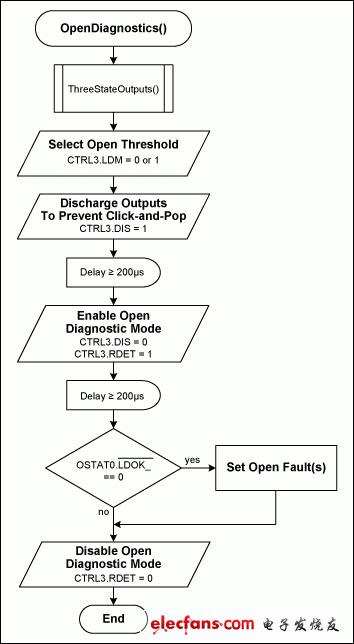Diagnosing Automotive Faults with Class D Audio Amplifiers(5)
Open Load Detection
This diagnostic detects an open between OUT_+ and OUT_- of > 70Ω or > 200Ω, depending on the value of the CTRL.LDM (load detect threshold) bit.
To detect open loads, three-state the outputs through I²C and discharge the output capacitors by setting the CTRL3.DIS (discharge) bit to 1. Run the open-load diagnostic test by setting CTRL3.RDET (open-load diagnostic enable) to 1. During the diagnostic, all low-side FETs on negative outputs (OUT_-) are turned on while all other FETs are turned off. The device sources a 2mA current from OUT_+ to OUT_-. If a load is not present, OUT_+ swings high and its relatively high VOUT_+ is interpreted as an open output. Results of the diagnostic are reported in the OSTAT0./LDOK[3:0] (load OK indicator) bits.
Step-by-Step Procedure (Figure 6)
- The outputs must be in three-state mode with the charge pump active (CTRL2.STBY = 0). If starting from MUTE or PLAY mode, follow the normal shutdown procedure to prevent click-and-pop.
- Set CTRL3.LDM based on application requirements.
- Discharge the outputs to ground by setting CTRL3.DIS = 1 to prevent click-and-pop during diagnostics.
- Wait at least 200µs.
- Enable the open-load diagnostic by setting CTRL3.RDET = 1 and CTRL3.DIS = 0.
- Wait at least 200µs.
- Read OSTAT0.LDOK[3:0] for results.
- Disable the open-load diagnostic by setting CTRL3.RDET = 0.

Figure 6. Open-load diagnostic procedure.
- 第 1 頁(yè):Diagnosing Automotive Faults with Class D Audio Amplifiers(1)
- 第 2 頁(yè):Three-State Procedure#
- 第 3 頁(yè):Load Diagnostics#
- 第 4 頁(yè):Short-to-Ground Diagnostic Procedure#
- 第 5 頁(yè):Open Load Detection#
- 第 6 頁(yè):Shorted Load/Resistance Measurement Detection#
- 第 7 頁(yè):Tweeter Detection#
- 第 8 頁(yè):Continuous Diagnostics#
本文導(dǎo)航
非常好我支持^.^
(0) 0%
不好我反對(duì)
(0) 0%
相關(guān)閱讀:
- [新品快訊] 新唐科技推出emPowerAudio系列ISD810X音頻功放 2011-03-22
- [電子動(dòng)態(tài)] Wolfson推出高傳真音訊(HD Audio)新產(chǎn)品線 為PC和NB掀 2011-01-27
- [廠商新聞] 歐勝面向電腦和筆記本電腦推出高清晰度音頻( 2011-01-09
- [新品快訊] 歐勝微電子推出WM8958音頻中心(Audio Hub)解決 2010-11-08
- [模擬技術(shù)] High-efficiency Class D audio 2010-09-22
- [LED電路] 9個(gè)LED組成的音頻電平表電路, Audio VU mete 2010-03-28
- [模擬技術(shù)] TV audio amplifiers—thermal te 2010-03-03
- [新品快訊] ADI推出Audio Processor全系列提供多組的DA 2010-01-25
( 發(fā)表人:愛電路 )
